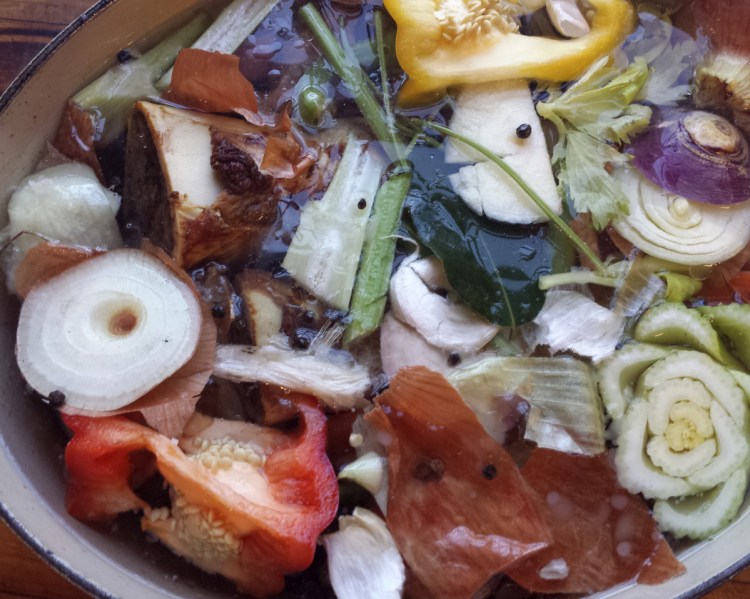When a day is damp and cold, I set a stockpot to simmer on the stove. It takes the chill out of the kitchen, scents the air throughout the house, and puts to good use animal bones and vegetable scraps sitting, seemingly inedible, in the refrigerator. This winter provided ample opportunity for stock-making. I have gallons of beef, lamb, chicken, fish, cheese rind and vegetable stock in the freezer.
I was feeling like a really green cook until I heard what Canadian chef Jean-Philippe Tees does with his kitchen scraps. Speaking to an audience of culinary colleagues at the 2018 Chef Summit held last month at O’Maine Studio in Portland about making the most of local flavor on a plate, Tees said in the kitchen of his Montreal restaurant, HVOR, he uses scraps not just once, but sometime two or three times more, to further reduce the waste of and increase the value of the local products he either grows or buys.
For example, he ferments tough foraged mushroom stems and then presses them to extract a juice he uses like soy sauce. After that, he dries out the pressed stems and grinds them into a powder. This umami-packed powder deepens the flavor of vegetarian dishes.
That’s all well and good for a dedicated professional, but is that sort of waste reduction feasible in the home kitchen? Is there a scaled-down version for reusing kitchen scraps multiple times that can fit wedged between a full-time desk job, full-time household responsibilities and the recommended eight hours of sleep?

Chilled fat sitting atop cooled beef broth.
Back in my kitchen I’ve always thought the point of making stock was to suck any culinary life left in the ingredients, out of them. So why, after I strain the solids from the resulting stock, do I feel guilty about dumping them into the compost bucket? Even more so after listening to chef Tees.
Spent bones are spent bones. I can’t even give those to my dog as they break off in shards that are dangerous to his digestive tract. And the vegetables used in meat stocks simmer for 4 to 6 hours, so are rendered to a mushy, mealy tasteless mess. I have taken bigger carrot, parsnip and onion bits out of my vegetable stockpot and pureed them to use as gravy thickener. I’m able to do so because it takes only 45 minutes of simmering to make a vegetable stock, so they still retain a bit of flavor.
The only other usable byproduct of the meat stock-making process is the fat that settles on top once strained beef, chicken and lamb stock has been chilled. You can roast the bones first to render some of the fat off before chucking them in the pot or you can just put the raw bones, carcass, and optional meat into a stockpot, add aromatic vegetables scraps (I highly recommend at least a few shallots skins as they add a lovely amber color) and simmer for anywhere from 4 to 12 hours, strain the stock, compost the solids, and let the stock cool to room temperature before putting it in the freezer to chill.
Once chilled, the stock will have a solid layer of fat on top. Simply peel this off and use it as is to add flavor to roasted potatoes (see recipe) or use it as the base of a roux for gravy. But ridding the fat of moisture and small specs of meat and veg that might have slipped through the sieve both makes it easier to work with (the liquid won’t sputter back at you when you melt the fat in a frying pan) and improves its shelf life. To clean the fat, simply melt it in a small pan on the stove or in a measuring cup in the microwave using very low heat. Let it cool until it is solid, turn it out of the pan or cup and use a knife to scrap off the stock that will have congealed on the top of your lump of fat. The fat will store in your refrigerator for about two weeks, but I generally freeze it in ice cube trays for long-term storage. Looking at my bag of rendered fat makes me feel a little less guilty about my full compost bucket.
CHRISTINE BURNS RUDALEVIGE is a food writer, recipe developer and tester and cooking teacher in Brunswick, and the author of “Green Plate Special,” a cookbook from Islandport based on these columns. She can be contacted at cburns1227@gmail.com.
Send questions/comments to the editors.


